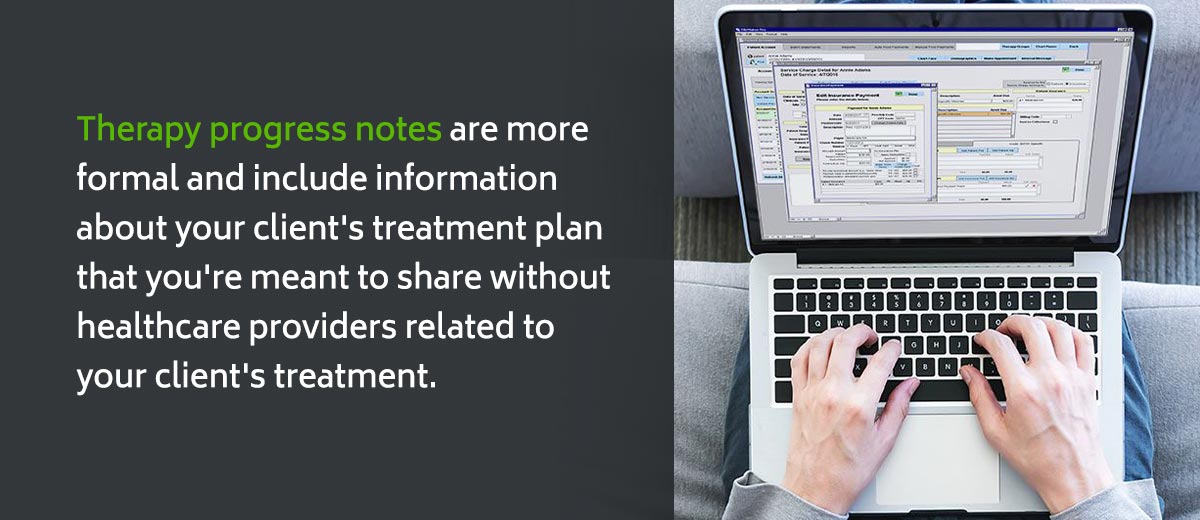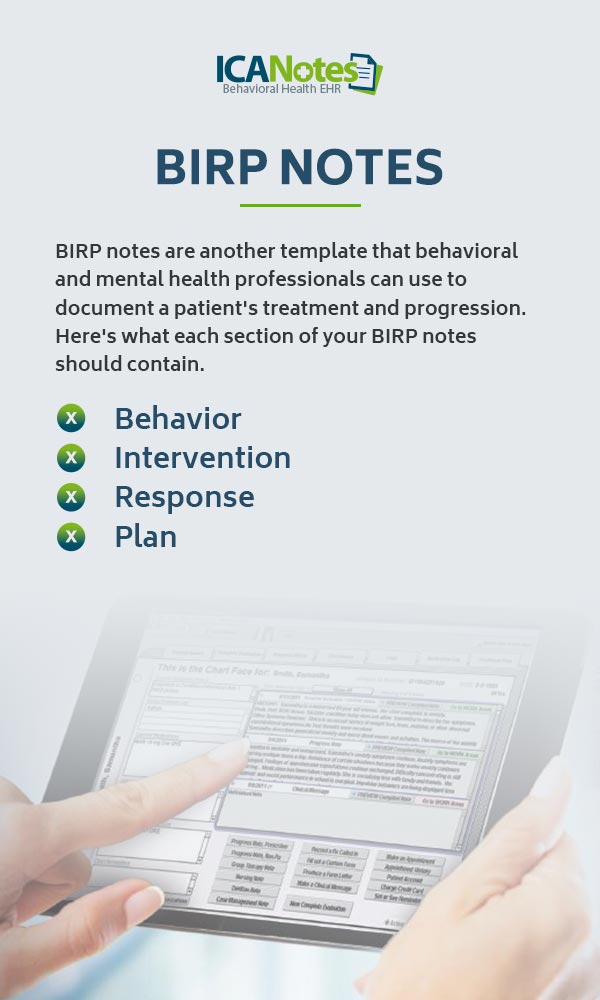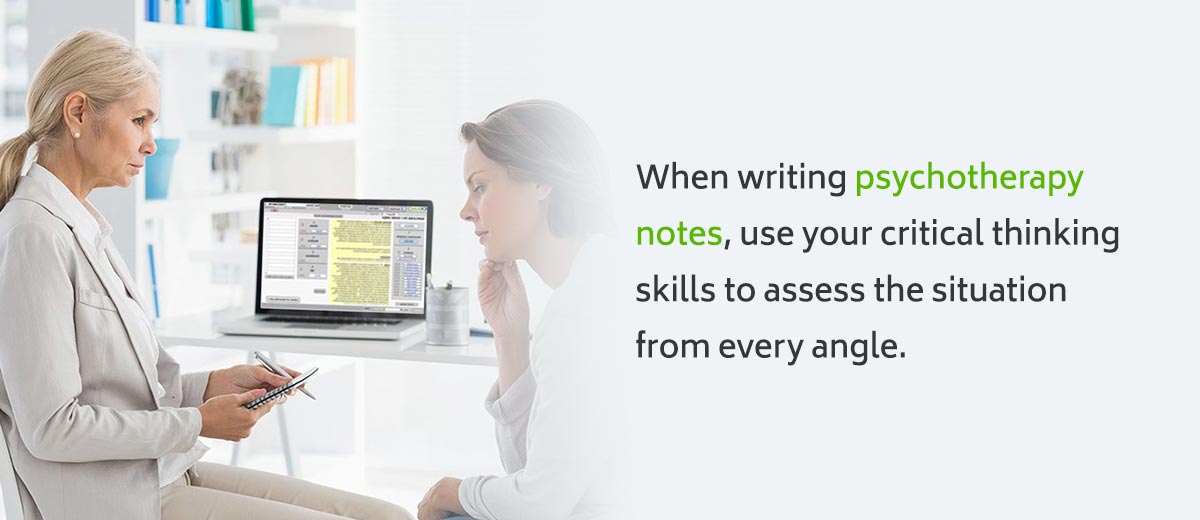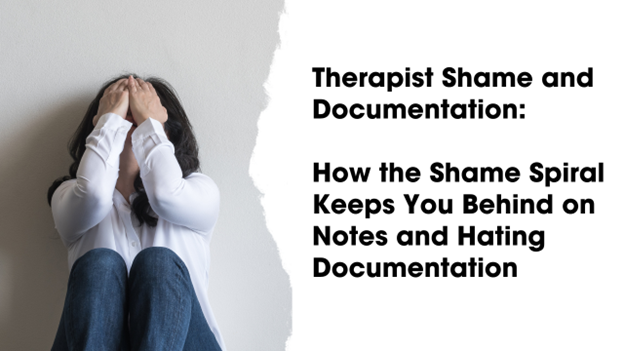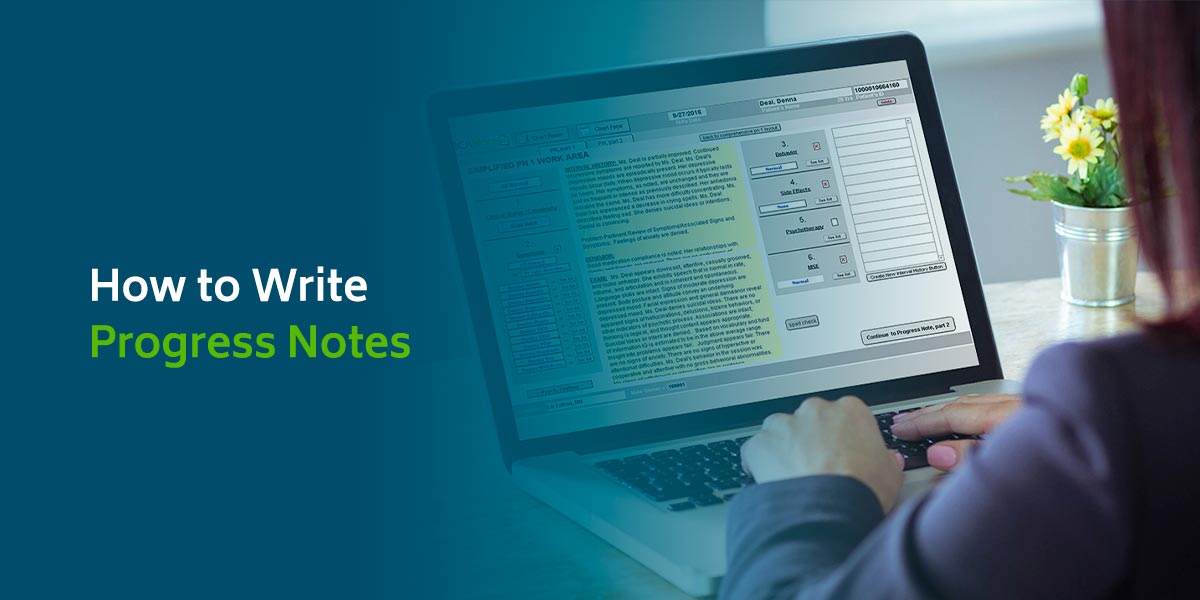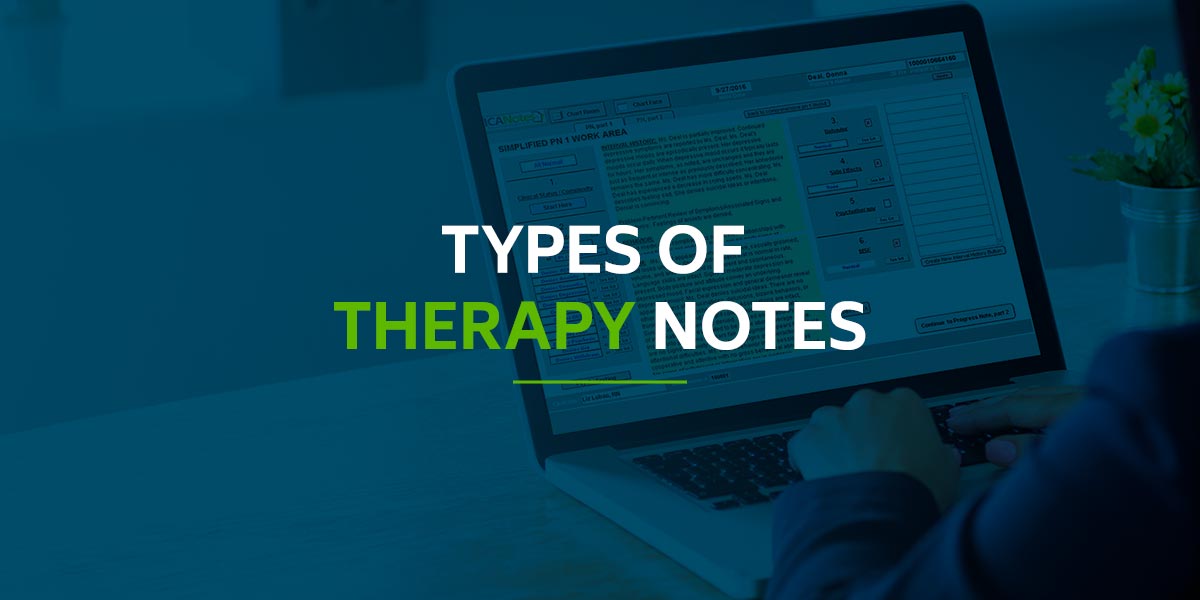
Types of Therapy Progress Notes with Examples
As a therapist or mental health professional, writing therapy notes is one of the most common, important parts of your career. From the moment you meet your patient for the first time to when they reach their therapeutic goals, your notes act as stepping stones for you to reference and see their progress.
You might document many types of clinical notes from patient to patient, so it's important to know how to get them done quickly, accurately and efficiently. Below, we'll discuss the different types of therapy notes you'll likely have to write and tips for making this process easier.
Write Better Therapy Notes in Less Time
Download our Guide to Efficient Clinical Notes in Behavioral Health
This guide covers key components of documentation, streamlined note-writing techniques, and best practices for organizing treatment plans and progress notes. It's an essential resource for any clinician looking to save time while maintaining high standards in documentation.
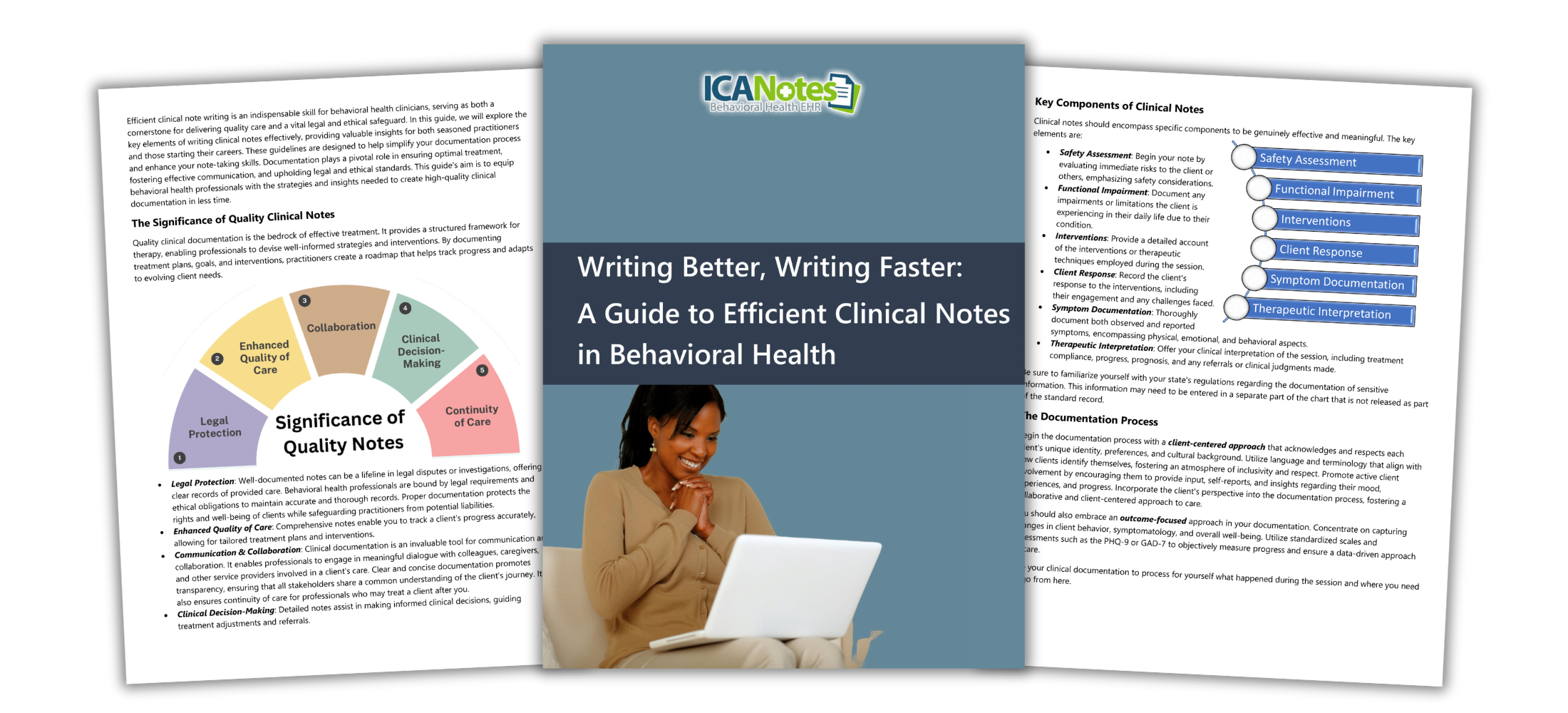
Psychotherapy Notes
Psychotherapy notes, also called process notes, are the notes you write during or after a session with your patient. Therapists commonly use these types of notes for making general outlines of a session, including:
- Observations
- Demeanor of patient
- Hypotheses about a diagnosis
- Thoughts and feelings about the session
- Questions
These notes are typically very detailed and should be kept separate from progress notes or other documentation about your client, such as medical records or billing information. You can use your psychotherapy notes as a reference when creating progress notes or drawing up an effective treatment plan.
Psychotherapy notes are private notes that your patients do not have the right to access, but you must obtain their permission before sharing them in some cases. Due to the sensitive nature of the information in these notes, the Health Insurance Portability and Accountability Act (HIPAA) provides special protection for them under federal law — unlike progress notes.
Think of psychotherapy notes as your personal notes. They should not contain information about test results, medication details or summaries of any symptoms or progress.
Progress Notes
Unlike psychotherapy notes, therapy progress notes are more formal and include information about your client's treatment plan that you're meant to share without healthcare providers related to your client's treatment. Progress notes typically aim to cover three categories of information:
- Your observations of the client during the session
- What your observations mean
- How you and your client plan to resolve or work on it
These notes are often necessary to have on hand for insurance purposes, and much of the information in progress notes will likely be dictated according to the standards of the insurance company. Usually, you will need to include important elements of your patient's medical information, including:
- Diagnosis
- Prescriptions
- Type of therapy
When writing progress notes, keep in mind that they should be more formal and methodical than psychotherapy notes. They must be:
- Objective: Document all the facts and consider how your discussions with your client may affect their treatment plan.
- Concise: Keep your words simple and to the point — avoid embellishing.
- Relevant: Ensure your notes and observations are relevant to your client's purpose for seeking treatment.
- Well-written: Keep your notes organized, and be sure to write in complete sentences.
Progress notes help you and your staff communicate more effectively about a patient's medical history, treatment plan, overall care and other essential information. Keeping your progress notes up to date is essential because it allows you to pick up where you left off each time you meet with your patient. Without updated notes on your client's progression through their treatment plan, you could end up wasting valuable time and effort.
Progress notes are also essential for conducting billing and reimbursement processes, so these documents must be clearly written and easy to access to help minimize mistakes or medical errors.
Although you can share your progress notes with other appropriate healthcare providers dealing with your patient, some elements of these notes are still protected under the HIPAA Privacy Rule, including:
- Any identifiable health information regarding the individual’s past, present or future physical or mental health
- The type of health care you provide to your patient and the reasons for the type of care
- Information relating to the past, present or future payment for the care and treatment you provide
SOAP Notes
SOAP notes are one of the most common types of notes that are easily broken down into four components in the acronym “Subjective, Objective, Assessment and Plan.”
Subjective
Document your patient's condition based on the descriptions they give you about why they decided to seek therapy. Be sure to note their primary concerns or complaints in their own words, such as their symptoms or significant, traumatic life events. You can also include direct quotes or paraphrased statements they give you during the session to help you highlight their most pressing concerns.
Objective
Include any objective data as if you were conducting a physical examination of your client. Note their appearance, body language or any other facts you notice in your session. Avoid using judgments or opinions in your observations, such as describing your client as “hysterical.”
Assessment
Write down a summary of your patient's diagnosis. This part of your SOAP notes will bring your subjective and objective data together to come to a conclusion about the goals and interventions you addressed in the session. You can also include screening results or additional notes about further investigation.
Plan
Document your plan and describe what you will do to treat your patient. Include any tasks you assign to your client and note any follow-up information, lab orders, review of medications or referrals your patient needs. You can also document what you plan to discuss or do in your next session.
BIRP Notes
Like SOAP notes, BIRP notes are another template that behavioral and mental health professionals can use to document a patient's treatment and progression. However, these notes focus more on behavior. BIRP notes help ensure your patient continues to receive care, particularly if they see multiple therapists or if they change providers. The BIRP acronym can help you organize your notes into more specific sections, making it easy to keep updated records and accurate information, including Behavior, Intervention, Response and Plan.
Following the acronym can make it easier for you to keep to a standard format and keep your notes more consistent. With more organized notes, you can communicate patient information with other healthcare providers more effectively and reduce the risk of making mistakes in your documentation.
Here's what each section of your BIRP notes should contain.
Behavior
Document the primary problem that the client presents and how they appear. Note your impressions of your patient and include both objective and subjective observations. Note actions that make the patient seem frustrated, hesitant or unwilling to participate. Keep your notes concise and focused on the main concerns.
Intervention
Here, you'll want to focus on your methods to intervene and help your client reach their treatment goals. Provide a detailed, active account of what you did during the session, such as questions you asked, techniques you used or decisions you made to adjust treatment to accommodate objectives.
Response
Document the patient's response to your intervention methods and how they reacted to your treatment. You can record specific details about what they said, questions they asked or if they changed their mind about treatment.
Plan
Plan your next session with your patient and record the time and date when you will meet again. You should also include what you plan to focus on in the next session and whether you assigned any homework for your client to complete before the next appointment.
DAP Notes
Another acronym format for note writing is DAP notes, which focus on Data, Assessment and Plan. DAP notes are a quick and effective way to write notes and are a bit more condensed than SOAP or BIRP notes.
Data
As with other note formats, the first section of these notes is where you will document your subjective and objective observations, relevant behavior and any actions or descriptions from the patient that could affect their treatment methods.
Assessment
Once you note the relevant behaviors, use the assessment section to document what these behaviors mean. Here, you can analyze the data you've collected from your session and note what you think the actions mean. Along with the in-session data, you can also include your patient's response to any interventions or techniques you conduct during your meeting.
Plan
As with SOAP and BIRP notes, the last section in DAP notes is where you will note follow-up instructions for your patient and possible therapeutic interventions you will conduct in the future. By now, you have gathered enough notes and data through discussion and observation and assessed it accordingly. You can use what you've learned during your session with your patient to document an appropriate treatment plan.
Group Notes
Running a group therapy session, such as family therapy, can easily become complicated if your notes are unorganized or not detailed enough to differentiate from every patient in the group.
In your group notes, you should have a separate record for each member to keep their individual progress on track. You can also include generalized notes about how the group interacts and what interventions you plan for them.
In group notes, you'll need to include many other elements compared to when you work with only one patient. Here are some essential components of individualized group therapy notes:
- A group summary and synopsis.
- Identifying information and details for each member.
- Observations about each member's mood and body language. You can use a mental status exam checklist to help with these descriptions.
- Notes about each person's participation, behavior and response to other group members.
- Description of issues, events or problems presented between group members.
- Objectives and goals for each patient and how each group member can achieve them in their treatment plan.
- Interventions you used during the session to target each client's goals.
- The client's responses, feedback and suggestions about their treatment strategies.
- A plan for your future session and any homework you want to assign to each group member.
Tips for Writing Therapy Notes
Here are some additional tips to keep in mind when writing different types of therapy notes to help you improve your note-writing process.
Tips for Writing Psychotherapy Notes
When writing psychotherapy notes, use your critical thinking skills to assess the situation from every angle. Include your feelings and opinions in your notes, but keep in mind that these notes can be subpoenaed and viewed by others. Keep these notes separate from your others, and maintain confidentiality by password protecting any note documents.
Since these are optional, private notes, you can also use creative ideas or brainstorming techniques, such as diagrams, to help summarize each session.
Tips for Writing Progress Notes
Progress notes are a brief overview of how your client progresses or regresses with each session. Here are some tips to remember before starting your documentation:
- Read your notes before each session to refresh your memory
- Refer to your previous entries to ensure continuity and appropriate progress
- Write about events, situations or occurrences in your sessions as soon as possible
- Avoid using slang, jargon or too many abbreviations that could confuse you or other healthcare providers later on
Tips for Writing SOAP Notes
While SOAP is already a helpful acronym, you can use the OLD CHARTS acronym — primarily used for physical examinations in the healthcare industry — to help you write more specific notes about a patient's condition or symptoms:
- Onset: Discover when the patient's symptoms started.
- Location: Find out where the patient primarily experiences their symptoms.
- Duration: Document how long the patient has dealt with their symptoms.
- Character: Have the patient describe their symptoms using specific details.
- Alleviating or aggravating factors: Understand what actions or interactions reduce or increase the severity of the patient's symptoms.
- Radiation: Find out if the patient experiences physical symptoms of pain or stress.
- Temporal pattern: Do the symptoms appear in a pattern, such as when they are alone or in a crowded area?
- Symptoms associated: Are there any other symptoms that occur alongside the patient's main complaint?
Avoid writing your SOAP notes during your sessions. Instead, write personal notes that will help you document each item in more detail later. Additionally, be careful about using overly positive or negative phrasing in your notes or being subjective without evidence — this can lead to more opinionated and judgmental notes.
Tips for Writing BIRP Notes
To streamline your BIRP note-writing process, use these tips to help you write faster and more efficiently:
- Focus on writing two to three strong sentences for every section: Try to limit yourself to only a few sentences to help with concision unless there is a significant event or change in behavior.
- Give yourself a time limit: Set a timer and see if you can complete your BIRP notes from a session within that time frame. This will help you determine what you spend more of your time on.
- Use an EHR software: If you really need to reduce the time you spend writing notes, using an electronic health record (EHR) can give you all the tools and templates you need to be more efficient.
Tips for Writing DAP Notes
To make your DAP notes more effective, follow these tips:
- Understand the outcome you're looking for: Define what a perfect document or note looks like to you and try to get as close as possible to it. What information do you need about your patient and the session to create a treatment plan for them. What information is useful and helpful?
- Keep it simple: Avoid overcomplicating your notes and keep them as relevant as possible. For instance, instead of noting the temperature in the room when your client entered the session, document their demeanor when they greeted you. Write information that you can actually use.
Tips for Writing Group Therapy Notes
When writing group therapy notes, there are some tips you should remember to keep them accurate and detailed enough to help develop effective progress:
- Avoid bias: Using objective language and keeping opinions out of your notes can help you remain focused on the clients' problems and progress. Otherwise, your documentation could suggest you favor one participant over the other.
- Keep it confidential: All mental health documentation should remain entirely confidential unless you are required to share it with other healthcare professionals or your patients.
ICANotes Simplifies Therapy Note Documentation
No matter which type of therapy note you use—SOAP, DAP, BIRP, or process notes—ICANotes makes documentation faster, easier, and more compliant. Designed specifically for behavioral health, ICANotes offers a structured, menu-driven interface that allows clinicians to create detailed, personalized notes in just a few clicks. Notes are automatically time-stamped, formatted for audit-readiness, and integrated with the rest of the clinical record. Whether you're charting progress, recording interventions, or documenting clinical observations, ICANotes ensures your notes are thorough, professional, and support medical necessity—without the burden of excessive typing.
Start Your Free Trial - no credit card required!
Drowning in Documentation?
Download the Guide to Writing Better, Faster Clinical Notes.
✅ Streamline your progress notes
✅ Avoid common documentation pitfalls
✅ Write defensible, high-quality notes in less time
✅ Stay compliant and boost treatment outcomes
*Includes practical templates, note format comparisons (SOAP, DAP, BIRP),
and real-world tips to reduce your charting workload without cutting
corners.

